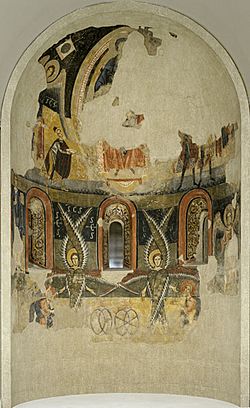Apse of Santa Maria, Àneu facts for kids
Quick facts for kids Apse of Santa María, Àneu |
|
|---|---|
 |
|
| Artist | Circle of the Master of Pedret |
| Year | Late 11th century - early 12th century |
| Type | Fresco transferred to canvas |
| Dimensions | 700 cm × 410 cm (280 in × 160 in) |
| Location | Museu Nacional d'Art de Catalunya, Barcelona |
The Apse of Santa María d'Àneu is a special part of a church. An apse is a rounded end of a church building, usually where the altar is. This one is from the Santa Maria, Àneu church. It was made a long time ago, around the late 1000s or early 1100s.
The beautiful paintings, called frescos, were moved from the church. Now, you can see them at the Museu Nacional d'Art de Catalunya in Barcelona. These paintings mix ideas from the Old Testament and the New Testament of the Bible.
Contents
What is the History of the Apse?
The Church of Santa María d'Àneu is in the Pyrenees mountains. It is in a high valley called Noguera Pallaresa. This building used to be a Benedictine Monastery.
The church has a main area called a nave and side areas called aisles. It has six pairs of pillars that make it look like a cross. The back of the church has three rounded apses. The middle apse is the one with the famous paintings.
Santa Maria in Àneu was the most important church in its valley. It belonged to the church leaders of Urgell. The style of the paintings is similar to the "Circle of Pedret," which was influenced by art from Lombardy.
The paintings show a detailed plan of religious ideas. They connect the hopes of the Old Testament, which looked forward to a savior, with the New Testament, which tells about the savior's arrival. The museum says the paintings were made between the late 11th century and early 12th century. Some people think they might have been finished later, around the early 13th century. This was when the older Romanesque art style was changing to the newer Gothic art style.
What Do the Paintings Show?
The paintings in the apse show many figures and scenes. They include prophets from the Old Testament. These prophets are shown in a respectful way.
In the top part of the apse, you can see the Epiphany. This scene shows the Adoration of the Magi. It features Mary, Jesus, and the three wise kings bringing gifts. Below this, there are "wheels of fire." These are from a vision described by the prophet Ezekiel in the Bible. They symbolize God's presence.
On the right and left sides, there are archangels. These are important angels named Michael and Gabriel. They hold banners and scrolls with special words on them. Near the central window, there are two six-winged seraphim. These are another type of angel. They hold hot coals with tongs. They place these coals in the mouths of two figures who are crouching.
In the lower left part of the apse, there are two figures with shaved heads. These might be Saints Benedict and Bernard. Or, one of them could be a local church leader. This idea comes from how real the face looks. Other similar paintings found at the monastery of Saint Peter of Berga also show figures like these. The third archangel, Raphael, is not with Michael and Gabriel. He is shown in a lower section of the painting.
At the very bottom, the paintings show biblical prophecies. These combine ideas from the visions of Isaiah and Ezekiel. Two seraphim purify the mouths of the prophets with glowing embers. The prophets are shown with their hands together, showing respect.
The seraphim also sing a song of praise to God. This is shown by the letters SCS, SCS, SCS, which mean 'holy, holy, holy'. After this, the words of the prophets are seen as God's words. Under the central window, there are the wheels of fire from Ezekiel’s vision. These wheels symbolize God's presence.
On the top part of the apse, there was a painting of the Virgin Mary and baby Jesus. This showed that the prophecies had come true. This scene was part of the Epiphany. Archangels Michael and Gabriel were also there. They are seen as protectors of people who have sinned. This scene is very much like one in the apse from Santa Maria in Cap d'Aran. Archangel Raphael is on the right side of the apse. He might be introducing the two church leaders shown on the left.
Who Painted It?
The frescoes are thought to be by artists from the Circle of the Master of Pedret. The Master of Pedret was a very important painter during the Romanesque period in Catalonia. This artist is named after the wall paintings found in the church of San Quirze de Pedret in Berga.
The Apse at Àneu shows the end of an old art style. At this time, painters might have felt free to change old rules. They could stop dividing the paintings into strict sections. So, the bottom part of the apse does not show rows of Apostles. Instead, it has more free elements from the prophetic visions.
Images for kids
-
On exhibit at the National Art Museum of Catalonia
See also
 In Spanish: Ábside de Santa Maria d'Àneu para niños
In Spanish: Ábside de Santa Maria d'Àneu para niños



